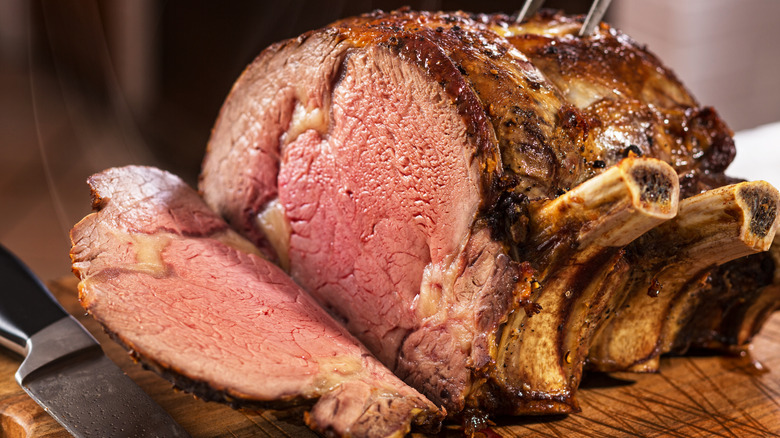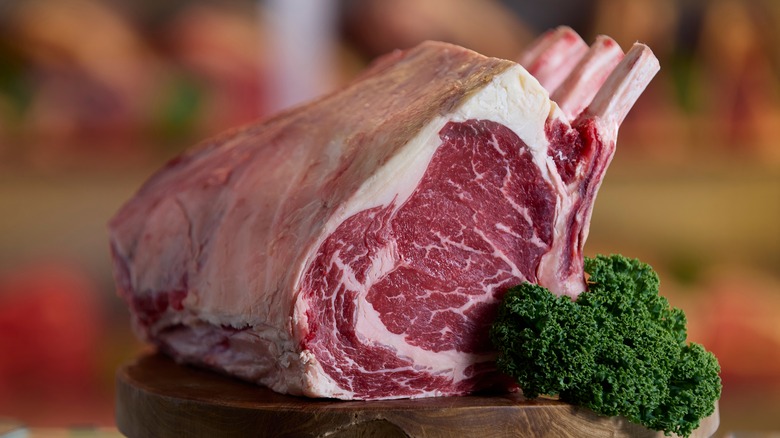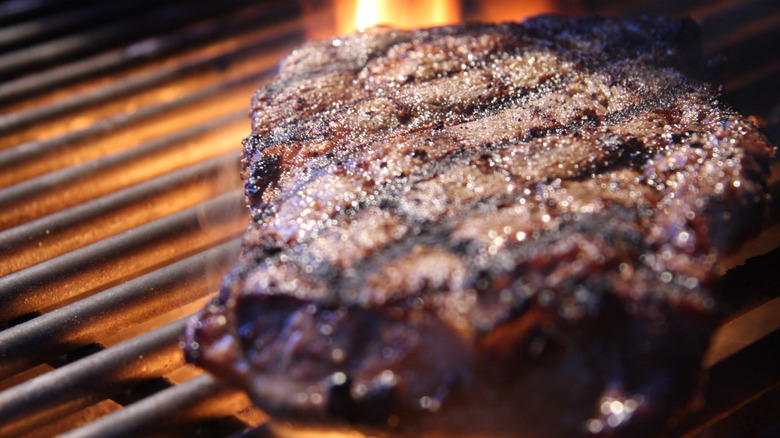Prime Rib Vs. Rib Roast: What's The Difference Between These Meats?
Trying to make sense of the many, many different cuts of beef you can buy at the market isn't for the faint of heart. These are big animals, after all, and butchery is a precise trade. It has to be: An average 1,200-pound steer yields about 750 pounds of beef, and that's a whole lot of meat to cut into usable pieces. Some classification system is needed.
Prime rib and rib roast are among the best cuts of meat you can buy, as they're both juicy and deeply flavorful. But these cuts — similarly named and taken from the same part of the cow — also present a bit of confusion: Are prime rib and rib roast the same thing? If not, what's the difference?
The short answer is that it depends who you ask. Many use the terms prime rib, rib roast, and prime rib roast interchangeably; prime rib is also often sold as standing rib roast. Others, though, contend that there are differences in the ways the cuts are butchered and cooked. Prime rib is roasted whole with the bone in, whereas rib roast sometimes refers to the general cut of meat that's subdivided into ribeye steaks, which can be boneless. As is often the case, the best course of action is to tell the person at the butcher counter what you need and let them help you find it. But here's some knowledge you can take with you to the shop.
What is prime rib?
First, let's admit that "prime rib" is a less-than-ideal name for this cut. Why? Because the USDA also uses the label "Prime" (along with "Choice" and "Select") in its own system of measuring beef quality, which it judges by fat marbling. "USDA Prime" denotes beef that's exceptionally well-marbled — in other words, the best you can get. A well-marbled prime rib might be designated as USDA Prime, but otherwise, that's not what the word means. Additionally, most USDA Prime cuts go to high-end restaurants rather than grocery stores. Here's more on the USDA's beef-grading system.
The "prime" in "prime rib" refers to the fact that this cut comes from the rib section — one of eight "primal" sections into which every beef cow is divided. There's also the chuck primal, the flank primal, and so on. Cows have 13 ribs on either side, which butchers count from front to back; "prime rib" refers specifically to ribs six through 12. The meat comes from what is essentially the cow's back. Those muscles don't get a whole lot of exercise (after all, you don't see cows bending over too often), meaning they're incredibly tender.
So, what can you expect when purchasing and cooking prime rib? A big, well-marbled cut that's great for roasting and looks fabulous in the center of the table, sliced to reveal a beautiful, rosy-pink color in the middle and begging to be served with horseradish and/or jus. Need a recipe? Try Bobby Flay's prime rib.
What is rib roast?
Important to note is that "rib roast" is often used to refer to the same cut of meat as prime rib, along with terms like "standing rib roast." What's the difference, then? This isn't a hard and fast rule, but prime rib is often sold with the bone in. That's one thing that can differentiate prime rib from cuts simply labeled "rib roast" — the latter cut comes from the same rib primal of the cow, but it's less likely to be sold and cooked with the bone in. You might come across boneless rib roast, for instance.
The rib roast also refers to the general cut that ribeye steaks come from — this is famously one of the tastiest, juiciest pieces of meat you can find (here's everything you need to know about it). The difference between cooking prime rib and cooking ribeye steaks, then, breaks down to the difference between how you generally approach roasts and steaks: With a longer-cooking roast, you may want to apply a reverse sear — that is, cook it in a relatively low oven until it reaches the desired internal temperature, then crank up the heat to give it a good sear on the outside. Better for individual servings, ribeye steaks are wonderful on the grill because high heat will melt the fat in the meat and contribute to a crisp, juicy crust, though they can also be pan-seared.


